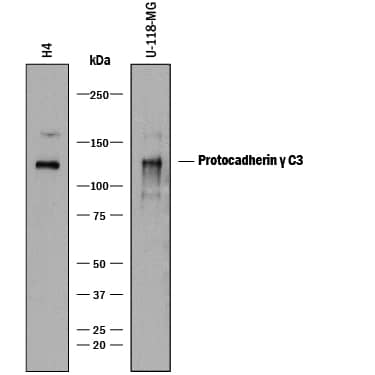Human Protocadherin gamma C3 Antibody
R&D Systems, part of Bio-Techne | Catalog # MAB8364

Key Product Details
Species Reactivity
Human
Applications
Western Blot
Label
Unconjugated
Antibody Source
Monoclonal Mouse IgG1 Clone # 926525
Product Specifications
Immunogen
Chinese hamster ovary cell line CHO-derived recombinant human Protocadherin gamma C3
Met1-Tyr693
Accession # Q9UN70
Met1-Tyr693
Accession # Q9UN70
Specificity
Detects human Protocadherin gamma C3 in direct ELISAs.
Clonality
Monoclonal
Host
Mouse
Isotype
IgG1
Scientific Data Images for Human Protocadherin gamma C3 Antibody
Detection of Human Protocadherin gamma C3 by Western Blot.
Western blot shows lysates of H4 human neuroglioma cell line and U-118-MG human glioblastoma/astrocytoma cell line. PVDF membrane was probed with 2 µg/mL of Mouse Anti-Human Protocadherin gamma C3 Monoclonal Antibody (Catalog # MAB8364) followed by HRP-conjugated Anti-Mouse IgG Secondary Antibody (Catalog # HAF018). A specific band was detected for Protocadherin gamma C3 at approximately 120 kDa (as indicated). This experiment was conducted under reducing conditions and using Immunoblot Buffer Group 1.Applications for Human Protocadherin gamma C3 Antibody
Application
Recommended Usage
Western Blot
2 µg/mL
Sample: H4 human neuroglioma cell line and U‑118‑MG human glioblastoma/astrocytoma cell line
Sample: H4 human neuroglioma cell line and U‑118‑MG human glioblastoma/astrocytoma cell line
Formulation, Preparation, and Storage
Purification
Protein A or G purified from hybridoma culture supernatant
Reconstitution
Reconstitute at 0.5 mg/mL in sterile PBS. For liquid material, refer to CoA for concentration.
Formulation
Lyophilized from a 0.2 μm filtered solution in PBS with Trehalose. *Small pack size (SP) is supplied either lyophilized or as a 0.2 µm filtered solution in PBS.
Shipping
Lyophilized product is shipped at ambient temperature. Liquid small pack size (-SP) is shipped with polar packs. Upon receipt, store immediately at the temperature recommended below.
Stability & Storage
Use a manual defrost freezer and avoid repeated freeze-thaw cycles.
- 12 months from date of receipt, -20 to -70 °C as supplied.
- 1 month, 2 to 8 °C under sterile conditions after reconstitution.
- 6 months, -20 to -70 °C under sterile conditions after reconstitution.
Background: Protocadherin gamma C3
References
- Yagi, T. (2008) Dev. Growth Differ. 50:S131.
- Sano, K. et al. (1993) EMBO J. 12:2249.
- Kohmura, N. et al. (1998) Neuron 20:1137.
- Obata, S. et al. (1995) J. Cell Sci. 108:3765.
- Hambsch, B. et al. (2005) J. Biol. Chem. 280:15888.
- Haas, I.G. et al. (2005) J. Biol. Chem. 280:9313.
- Bonn, S. et al. (2007) Mol. Cell. Biol. 27:4121.
- Reiss, K. et al. (2006) J. Biol. Chem. 281:21735.
- Wang, X. et al. (2002) Neuron 36:843.
- Phillips, G.R. et al. (2003) J. Neurosci. 23:5096.
- Weiner, J.A. et al. (2005) Proc. Natl. Acad. Sci. USA 102:8.
- Lefebvre, J.L. et al. (2008) Development 135:4141.
- Prasad, T. et al. (2008) Development 135:4153.
- Lin, C. et al. (2010) J. Biol. Chem. 285:41675.
- Chen, W.V. et al. (2012) Neuron 75:402.
- Garrett, A.M. et al. (2012) Neuron 74:269.
- Lobas, M.A. et al. (2012) J. Neurochem. 120:913.
- Ledderose, J. et al. (2013) Sci. Rep. 3:1514.
Alternate Names
Cadherin-Like 2, PCDH2, PCDHGC3, Protocadherin 43, Protocadherin-2
Gene Symbol
PCDHGC3
UniProt
Additional Protocadherin gamma C3 Products
Product Documents for Human Protocadherin gamma C3 Antibody
Product Specific Notices for Human Protocadherin gamma C3 Antibody
For research use only
